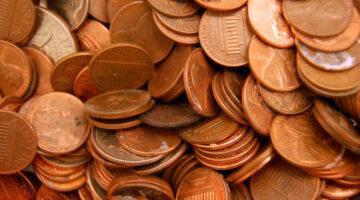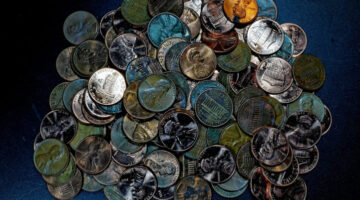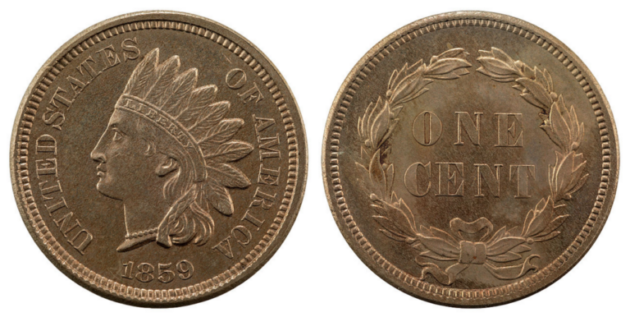I love to collect pennies.
I’ve been collecting pennies (U.S. one-cent coins) since I first jumped into the hobby in 1992 — and I still enjoy them today.
I continue to find old pennies, penny errors, and other interesting, valuable pennies in pocket change today, and all for merely their face value.
Imagine finding rare pennies in your spare change for just one cent a coin!
What’s cool about pennies, too, is that because it’s easy to find old coins in circulation, you can build all kinds of neat coin collections from the coinage that turns up in your pocket or purse.
Even if I have to spend a pretty penny to collect pennies that I buy from coin dealers, there’s still the thrill of the hunt… collecting the one-cent coin has always been at the heart of my numismatic journey.
Why? Well, just one of many reasons is because there are so many exciting ways to collect pennies!
You can collect pennies by type, by date, by mintmark, by year. You may even build collections of elongated pennies, novelty pennies, and pennies with weird errors, odd die varieties, or other unusual markings.
Here are 9 interesting ways to build a penny collection:
#1 – Collect Pennies By Type Or Design
Over the years, there have been dozens of major and minor design varieties among all pennies, counting both the large cents made from 1793 through 1857 and the small cents made since 1856.
Some coin collectors will focus their one-cent type coin sets based on only the major types, while others count all the design variations.
When building a type set like this, you would generally collect pennies representing each type, with the set normally containing just a single example per design.
For the sake of this article, I will list all of the major design varieties in bold and the minor ones in inset bullet points and regular font.
Here’s a rundown on the various penny designs and the years they were minted:
- Flowing Hair Cent 1793
- Chain Reverse 1793
- Wreath Reverse 1793
- Liberty Cap Cent 1793-1796
- Draped Bust Cent 1796-1807
- Classic Head Cent 1808-1814
- Liberty Head Cent 1816-1857
- Matron Head 1816-1835
- Modified Matron Head Or Young Head 1835-1839
- Braided Hair 1839-1857
- Flying Eagle Cent 1856-1858
- Indian Head Cent 1859-1909
- Variety 1 Copper-Nickel Laurel Wreath 1859
- Variety 2 Copper-Nickel Oak Wreath With Shield 1860-1864
- Variety 3 Bronze 1864-1909
- Lincoln Wheat Ears Cent 1909-1958
- Lincoln VDB Initials On Reverse 1909
- Lincoln No VDB 1909-1917
- Lincoln Bronze VDB Under Shoulders 1918-1942
- Lincoln Steel Composition 1943
- Lincoln Shell Case Composition 1944-1946
- Lincoln Bronze Composition Resumed 1947-1958
- Lincoln Memorial Cent 1959-2008
- Copper Alloy 1959-1982
- Zinc Alloy 1982-2008
- Lincoln Bicentennial Cent Series 2009
- Birth & Early Childhood 2009
- Formative Years 2009
- Professional Life 2009
- Presidency 2009
- Lincoln Shield Cent 2010-Present
#2 – Collect Penny Date Sets
If you want to collect more than just the relatively few specimens of one-cent coins that would go into a type collection, then perhaps you’d be smitten by the idea of building a date set.
In a date set, you collect pennies that represent examples of every year its series was in production.
So, for example, if you wanted to collect a date set of Lincoln Memorial cents, you would find one penny from each year that design was struck — which lasted from 1959 through 2008.
Penny date sets can be fun to build and are generally easy to assemble. With few exceptions, there’s at least one “cheap” representative specimen that can be collected from one or more of the mints during a given year.
#3 – Collect A Special Year Set Of Pennies
Is there a year that’s particularly special to you? Maybe your birth year? A wedding date? Perhaps the year you bought your first home?
If that’s the case, there’s a type of collection with your name on it: the year set.
In the case of most pennies made during the time when most of people alive today were born, there were at least 2 U.S. mints striking one-cent coinage.
Before 1956 and between 1968 and 1974, there were 3 U.S. mints striking Lincoln cents, including:
- Philadelphia (no mintmark)
- Denver (D mintmark)
- San Francisco (S mintmark)
For the sake of accuracy, I could also say that the San Francisco and West Point Mints were making pennies during the mid 1970s through early 1980s. But neither of those mints placed mintmarks on pennies, so they look just like regular, no-mintmark Philadelphia one-cent coins.
A penny year set would consist of the 1, 2, or 3 pennies from a given year — each in the best condition you can afford.
Unless your special year is from the 1910s, 1920s, or early 1930s — generally a period from which at least 1 Lincoln cent from a given year and particular mint is scarce and valuable today — you should have little difficulty affording a penny year set.
#4 – Collect Large Cents From the 1790s Through 1850s
When people talk about collecting pennies they often don’t think about collecting large pennies, or large cents as they are more formally called.
Back when coin collecting was really taking off in the United States during the latter 1800s, when someone said they were a penny collector, it meant they were putting together sets of these large copper coins.
The large cent was the first one-cent coin in the United States.
Measuring as wide as 29 millimeters in diameter (or nearly the size of a modern-day half dollar), the large cent was America’s copper penny during the first 64 years the United States Mint was producing Federal coinage.
A large cent collection may entail collecting one example of every date, a single specimen of every design type (listed above under #1), or simply as many as you can reasonably afford:
- 1793 large cents are worth $3,000 or more in grades of Good-4 and up.
- Large cents struck between 1794 and 1798 are priced between $125 and $350 or more in Good-4.
- 1799 Large cents are rare and worth about $3,000 and up.
- Large cents produced from 1800 through 1814 are usually valued at between $75 and $150 in grades of Good-4.
- Most large cents made since 1816 are worth between $20 and $50 in average circulated grades.
At any rate, here are some tips to consider when collecting large cents:
- There is no 1815 penny! If you find a U.S. one-cent coin with the 1815 date, it’s counterfeit.
- Early pennies from the 1790s are valuable in low grades such as Poor-1, Fair-2, and About Good-3, and they are even collectible if they’re cleaned.
- While cleaned early large cents are valuable, they’re preferred by most coin collectors in original condition — chocolate brown color on a large cent is indicative of originality and is highly desirable.
- Be choosy when buying large cents from a coin dealer, but also remember that most copper coins from the 1790s and 1800s have been exposed to many decades of wear and tear; very few are truly original, so aim to buy the best large cents you can afford, not necessarily a perfect coin.
#5 – Collect Indian Head Pennies
If collecting large cents is too expensive, you might consider working on a complete set of Indian Head pennies.
Struck from 1859 through 1909, the Indian Head cent is one of the most popular 19th-century United States coins to collect and is an expensive and challenging coin collecting goal — yet, not one that’s out of reach for coin collectors who have a bit of expendable income and a lot of patience.
About half of the Indian Head cents — primarily those made since 1880 — in the series can be bought for less than $5 each in circulated grades.
The other half of those Indian Head cents — mostly made before 1880 — cost $10 to $20 and up.
There are also a few rare Indian Head pennies that are valued at $50 or more. They include:
- 1864 with L — $50+
- 1866 — $50+
- 1867 — $50+
- 1869 — $75+
- 1870 — $50+
- 1871 — $70+
- 1872 — $85+
- 1877 — $900+
- 1908-S — $85+
- 1909-S — $450+
*These values are for coins in average circulated grades and don’t include specialized die varieties.
#6 – Collect Lincoln Wheat Pennies
There are few coins more popular than Lincoln cents and, more specifically, Lincoln wheat pennies.
Some call these pennies wheaties, wheat ears, and wheats, too.
Whatever you call them, you know one when you see it. They have the familiar side portrait of Abraham Lincoln on the obverse and 2 stalks of wheat bending along the rim of the reverse.
While wheat cents were made from 1909 through 1958 and are hard to find in circulation, most of them aren’t necessarily rare. In fact, most Lincoln wheaties are numismatically common.
Here’s a look at the values of Lincoln wheat pennies:
- There are several key date (or rare Lincoln wheat cents). Some are worth $100 or more.
- Semi-key Lincoln pennies made between 1909 and 1934 are scarce and worth $2 to $100.
- Lincoln cents made since 1934 are worth 3 to 10 cents each in circulated grades.
Though most Lincoln wheat cents are easy to find and cheap to buy, many dates are virtually impossible to find in circulation. Therefore, collecting an entire Lincoln wheat cent collection is a challenge for any hobbyist.
If you want to collect pennies representing the entire span of the Lincoln wheat series, you’ll have to buy many of them from a coin dealer.
Since it’s pretty much necessary to buy Lincoln wheat pennies from a coin dealer, that means you’ll also have to purchase the rarest dates. That’s probably the toughest part of finishing a Lincoln penny collection — buying the rare dates.
Check out the following prices for 3 rare Lincoln pennies:
- 1909-S VDB cent — $750+
- 1914-D cent — $175+
- 1922 no-D plain cent — $600+
It would cost nearly $1,500 to buy all of the necessary Lincoln wheat pennies to finish a basic wheatie collection.
Depending on whether or not the 1922 plain cent, 1955 doubled die penny, or other scarce varieties are included, the price for completing the set could easily exceed $2,200 to $2,500 or more.
#7 – Collect Lincoln Memorial Pennies
The Lincoln Memorial cent reverse replaced the wheat ears reverse in 1959 and was struck until 2008.
Lincoln Memorial pennies are still extremely common in pocket change today even though they were permanently replaced by the Lincoln Shield cent in 2010.
Billions upon billions of Lincoln Memorial cents were made over the course of 50 years, and there are very few dates that are considered scarce. In fact, it’s actually possible to assemble an entire basic set of Lincoln Memorial pennies right from circulation for face value.
While all regular-issue Lincoln Memorial cents are common, some are tougher to find than others in spare change.
Here’s a list of the more challenging Lincoln pennies you’ll need to look for to complete your collection:
- 1968-S cent — 7 to 10 cents
- 1969-S cent — 7 to 10 cents
- 1970-S large date cent 7 to 10 cents
- 1970-S small date cent — $30+
- 1971-S cent — 7 to 10 cents
- 1972-S cent — 7 to 10 cents
- 1973-S cent — 7 to 10 cents
- 1974-S cent — 7 to 10 cents
- 1982 small date copper cent — 7 to 10 cents
- 1982 small date zinc cent — 7 to 10 cents
There are also a few rare die varieties, including:
- 1969-S doubled die cent — $50,000+
- 1971 doubled die cent — $25+
- 1972 doubled die cent — $300+
- 1983 doubled die cent — $250+
- 1984 doubled die cent — $175+
- 1995 doubled die cent — $25+
- 1999 wide AM cent — $350+
Regular-issue copper Lincoln Memorial cents — which were made from 1959 through 1981 and part of 1982 — are worth 2 cents each.
Except for the dates and varieties listed above, circulated Lincoln Memorial pennies made from 1982 through 2008 are worth face value if worn.
Many collectors enjoy assembling Lincoln Memorial penny sets in coin folders — which are cheap to buy at bookstores, from coin dealers, and online.
#8 – Collect Pre-1982 Copper Pennies
Pennies are no longer made mainly from copper.
In fact, the last full year circulation-strike Lincoln cents were made from their traditional 95% copper composition:
- Ronald Reagan had just become president of the United States
- ABBA and the Bee Gees still had Top-40 hits on the radio
- NASA’s Space Shuttle Columbia was launched for its maiden voyage
- Three’s Company, The Jeffersons, M*A*S*H, and The Lawrence Welk Show were on TV
The year was 1981 — the last full year regular-issue Lincoln pennies contained a primarily copper alloy.
Just as rising silver prices squeezed precious metal out of the dime, quarter, and half dollar almost 20 years earlier, copper values rose to the point that the value of the metal was worth more than the face value of the one-cent coin!
In 1982, the Mint transitioned to its modern-day zinc-based composition.
About 2/3rds of 1982 Lincoln Memorial cents contain a mainly copper composition, while 1/3rd are considered Zincolns.
While some 1982 Lincoln cents are made from copper, it’s somewhat difficult to tell a copper 1982 cent apart from a zinc penny.
There are a few tell-tale ways to tell copper pennies from zinc pennies:
- Copper pennies weigh 3.11 grams, whereas zinc cents weigh 2.5 grams. (See how to weigh coins.)
- Copper 1982 pennies generally have a warmer orange color than their zinc counterparts.
- Drop a 1982 copper penny on a hard surface and it rings. Zinc 1982 cents clink.
Many people who collect pennies from 1982 set them aside in a separate pile and test them at one time, like the guy in this video:
Unless you’re willing to test every 1982 cent that comes your way, it’s pretty easy to visually tell the pre-1982 copper Lincoln cents apart from the modern-day pieces that have a 97.5% zinc, 2.5% copper composition by merely looking at the coin’s date.
Many people are hoarding old copper pennies with the hopes that it may be someday become legal to melt them for their copper value (it’s illegal to do so now).
All pre-1982 copper cents are worth 2 cents and up.
#9 – Collect An Entire 1909-To-Present Lincoln Cent Set
Perhaps the most popular of all ways to collect pennies is to assemble an entire collection of Lincoln cents made since 1909.
Such a collection would include the following types:
- Lincoln Wheat Ears Cent 1909-1958
- Lincoln VDB Initials On Reverse 1909
- Lincoln No VDB 1909-1917
- Lincoln Bronze VDB Under Shoulders 1918-1942
- Lincoln Steel Composition 1943
- Lincoln Shell Case Composition 1944-1946
- Lincoln Bronze Composition Resumed 1947-1958
- Lincoln Memorial Cent 1959-2008
- Copper Alloy 1959-1982
- Zinc Alloy 1982-2008
- Lincoln Bicentennial Cent Series 2009
- Birth & Early Childhood 2009
- Formative Years 2009
- Professional Life 2009
- Presidency 2009
- Lincoln Shield Cent 2010-Present
In addition to collecting business-strike Lincoln pennies, many who put together an entire Lincoln cent set will go the extra numismatic mile and include San Francisco-Mint proof Lincoln pennies.
S-Mint proof Lincoln Memorial cents are generally worth $1 and up.
While it’s possible to build much of the 1909-present Lincoln cent collection from pocket change, most of the earlier coins will have to be bought from a coin dealer.
This entire set, including only regular-issue strikes and S-Mint proof cents made since 1968, would cost $2,500 or more to build.
More About Collecting Pennies
- 1982 Cent Provides Collectors With Challenges, Rewards
- Collection Of Rare Pennies Fetches $10.7 Million
- Penny Hoarders Hope For The Day The Penny Dies
- 5 Money-Saving Tips For Collecting Lincoln Pennies
- 43 Most Valuable Pennies Worth Hanging Onto
I’m the Coin Editor here at TheFunTimesGuide. My love for coins began when I was 11 years old. I primarily collect and study U.S. coins produced during the 20th century. I’m a member of the American Numismatic Association (ANA) and the Numismatic Literary Guild (NLG) and have won multiple awards from the NLG for my work as a coin journalist. I’m also the editor at the Florida United Numismatists Club (FUN Topics magazine), and author of Images of America: The United States Mint in Philadelphia (a book that explores the colorful history of the Philadelphia Mint). I’ve contributed hundreds of articles for various coin publications including COINage, The Numismatist, Numismatic News, Coin Dealer Newsletter, Coin Values, and CoinWeek. I’ve authored nearly 1,000 articles here at The Fun Times Guide to Coins (many of them with over 50K shares), and I welcome your coin questions in the comments below!






